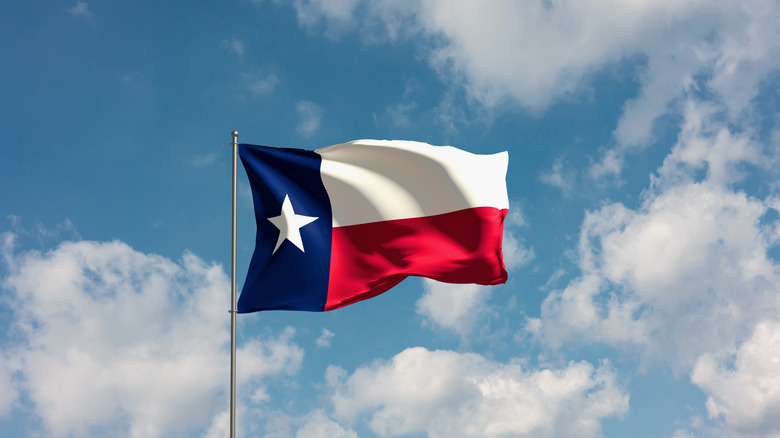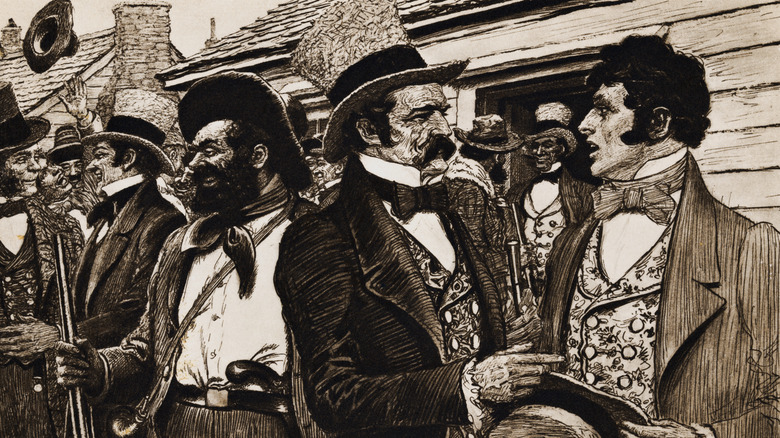Why Texas Is Called The Lone Star State
Texas is the second-largest American state behind Alaska in terms of area and behind only California in terms of population. Today, it's considered one of the Union's biggest success stories, with a strong heritage and world-famous identity as a cultural and economic powerhouse. Its identity among its people is so strong that they sometimes refer to the U.S. state as the "greatest country in the world," a tongue-in-cheek reference to its scale and power. More commonly, Texas is known as the "Lone Star State."
The name "Lone Star State" refers to the Texan flag, which contains a single white star on a blue, white, and red background. Texas first adopted the flag in 1836, with the design reportedly derived from another used during the 1819 James Long Expedition against Spanish control of the territory. Just as the stars on the United States flag refer to individual states, Texas' lone star can be taken the same way today. But for proud Texans who know their state's history, it can be said to refer to the decade when it was its own country — the period from which the flag dates.
Back before it was part of the United States, Texas had a period in which it existed as a country in its own right, making it a figurative Lone Star. Indeed, before it was part of America as we know it today, it was part of Mexico, and it spent some years as part of the Confederacy. A tumultuous war of independence led to a period in which it was briefly a lone star between these warring sides.
Becoming the Lone Star State
Texas' years as an independent state, which dated from signing of the Texas Declaration of Independence in 1836 and lasted for nine years, were hard won. Prior to that, it had been a part of Mexico, but the 1830s saw relations between the state and the Mexican government decline among a rash of legal measures taken by the government to weaken Texas' state power. Among them were the planned disarming of the Texas state militia and the abolition of the constitution.
In response, Texan rebels started a revolution, marching on the Mexican town of San Antonio, claiming the settlement, and holing up at the former Spanish fortress of the Alamo. In possibly the most famous stand in American history, around 200 rebels (including David Crockett) spent 13 days under siege from a vastly larger and superior Mexican force. They managed to smuggle out a valorous call for reinforcements and kill 600 enemy troops before being overrun and defeated. Though they had by then already declared independence, Texan forces then met the remaining Mexican attackers on the San Jacinto River on April 21, 1836, defeating them in a bloody battle that secured a reprieve from Mexican control.
Texas as part of the United States
For the new Republic of Texas, independence wasn't exactly proving to be a success. Though the state had pulled together to fend off Mexico, there were huge internal problems. As well as being crippled economically by the Texan Revolution, the new country struggled to be recognized on the international stage due to slavery still being legal in the region. Even as Texas lobbied the United States to annex it, Texas' unwillingness to join the northern states in abolition caused political turmoil. Economically, it meant that other nations refused to buy Texan cotton, its major export, and it faced bankruptcy.
Texas was annexed by the United States in 1845, with the resulting bloody U.S.-Mexico War lasting two years and continuing the turmoil of the period. The years that followed saw Texas boom economically, with the cotton industry expanding across the South as slavery took hold in the states the U.S. claimed during the Mexican Cession. However, as the slavery debate heated up in America, Texas sought a break, and it gained one in February 1861, when it joined the Confederacy. It was only after the Civil War, when the United States defeated the Confederacy, that slavery ended in Texas. By the time it returned to being a part of the U.S., it had already been a state aligned to either side, Mexico, as well as an attempted independent state. Truly, a lone star and a state with a unique, checkered history.


